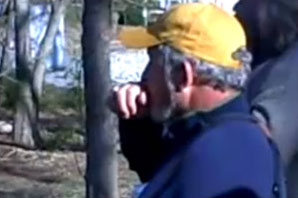Pratique | Conseils
Pratiquer le pishing : oui, mais avec prudence

Observateur pratiquant le « pishing » aux États-Unis.
Source : Great Smoky Mountains Association (2010)
Introduction
Le « pishing » est un terme désignant les sons plus ou moins aigus (du type « pshhh pshhhh pshhh » ou « tsssssss tssssss tsssss »), imitant notamment les cris d’alarme de mésanges, utilisés par les observateurs pour faire réagir ou attirer certains oiseaux afin de mieux les observer. Cette technique ancienne est davantage pratiquée par les ornithologues nord-américains qu’européens : elle est pourtant assez efficace sur une grande variété d’espèces et peut servir à améliorer les comptages.
Après une présentation du pishing, nous expliquerons pourquoi il fait réagir de nombreux oiseaux puis nous rappellerons les risques d’une utilisation non raisonnée.
Abstract
Pish is an imitated bird call (usually a scold or alarm call) used by birders and ornithologists to attract birds (generally Passerines). The action of making the sound is known as pishing. This technique is used by scientists to increase the effectiveness of bird diversity surveys, and by birders, mainly North-American, to attract species that they might not otherwise see. Pishing is used most effectively in the Holarctic, where it is thought to work due to its similarity to the scold calls of tits and chickadees (birds in the family Paridae). These scold calls, a form of mobbing behaviour, attract other birds which come in to establish the nature of the potential threat.
After a description of the method, we’ll present the reasons why numerous species of birds are attracted and the potential objections and dangers to use the pishing without caution.
Poursuivez la lecture de cet article, en vous abonnant dès maintenant !
Découvrez les Archives d’Ornithomedia.com
Pour seulement 10,00 €TTC/an (ou 6,00 € les 6 mois)
Profitez de plusieurs centaines d’articles en accès illimité et sans aucun engagement.
Compléments
Ouvrage recommandé
The Art of Pishing: How to Attract Birds by Mimicking Their Calls Pete Dunne
Sources
- Gary M. Langham, Thomas A. Contreras et Kathryn Sieving (2006). Why pishing works : Titmouse (Paridae) scolds elicit a generalized response in bird communities. Ecoscience. 13(4). Pages 485-496. http://www.wec.ufl.edu/faculty/sievingk/PUBS/Pishing.pdf
- J. Ryan Zimmerling et C. Davison Ankney (2000). A Technique That Increases Detectability of Passerine Species during Point Counts. Journal of Field Ornithology. Vol. 71, No. 4, pages 638-649. http://www.jstor.org/pss/4514533
- NEAL GRIFFITH SMITH (1975). « Spshing Noise »: Biological Significance of Its Attraction and Nonattraction by Birds. Proc. Nat. Acad. Sci. Vol. 72, No. 4, pages 1411-1414. http://www.ncbi.nlm.nih.gov/pmc/articles/PMC432544/pdf/pnas00047-0197.pdf
- Emlen, J.T (1969). The ‘squeak lure’ and predator mobbing in wild birds. Anim. Behav. 17:515-516.
- Ryan Zimmerling. Bringing in the birds. Birdwatch Canada. http://www.bsc-eoc.org/download/BWCfa05.pdf
- Rasmus Boegh. Tape Luring – the use of playback. http://www.birdforum.net/showthread.php?t=31961




Aucun commentaire sur ce sujet
Participer à la discussion !